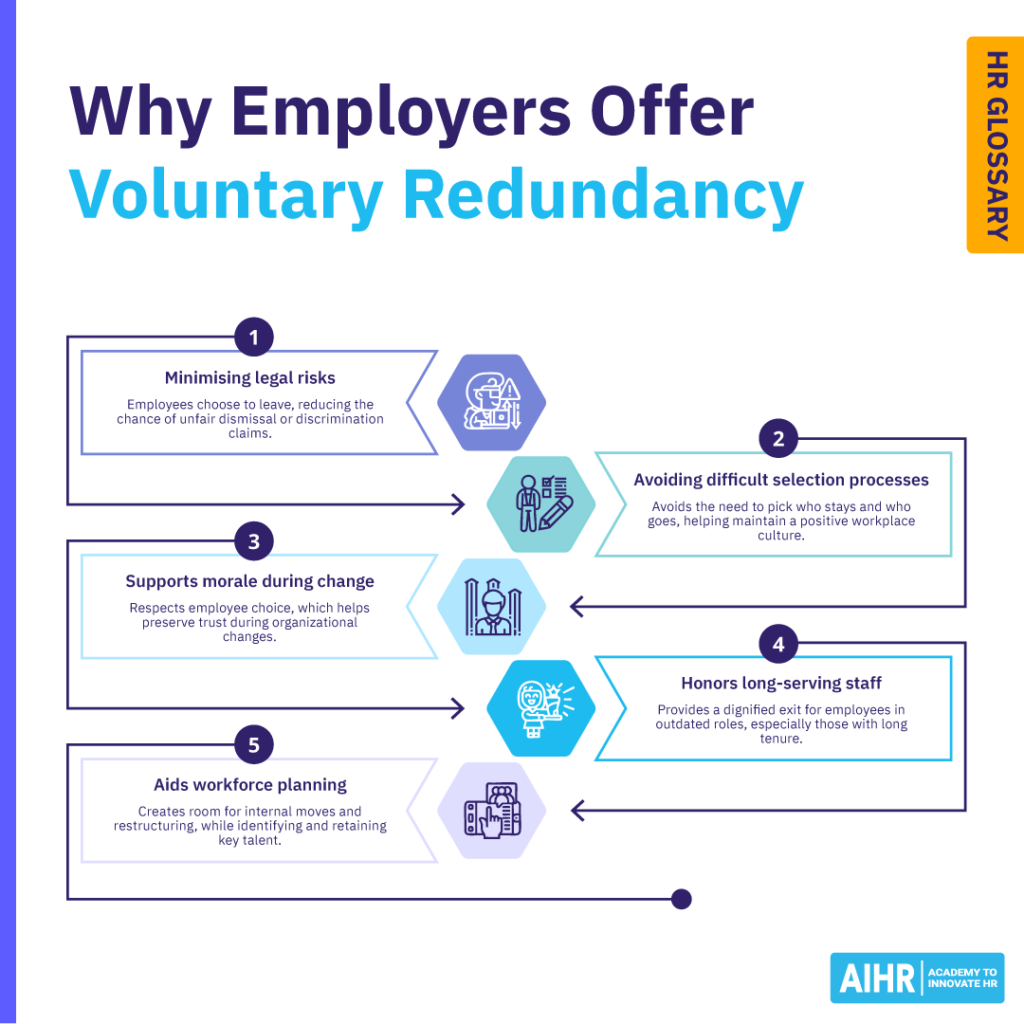Voluntary Redundancy
What is voluntary redundancy?
Voluntary redundancy is a workforce reduction method where an employer invites employees to nominate themselves for redundancy, often with a financial incentive. It differs from compulsory redundancy in that it allows employees to leave on their own terms.
The process is used during restructures, downsizing, or when roles become redundant due to technological or operational changes. While the employer initiates the process by offering redundancy packages, it’s up to employees to decide whether to accept the offer.
These packages often include severance payments above the legal minimum to encourage uptake. Voluntary redundancy is usually seen as a more respectful and less disruptive approach than forced redundancies, particularly when reducing headcount or phasing out specific roles.
Why do employers offer voluntary redundancy?
Voluntary redundancy is a strategic workforce management tool that lets employers reduce employee numbers while minimizing legal, cultural, and operational disruption. The benefits include:
- Minimized legal risk: Terminating an employee’s role can lead to disputes over unfair dismissal or discrimination. By offering voluntary redundancy, employers reduce the likelihood of claims, as employees must opt into the process.
- Avoidance of difficult selection processes: Choosing which roles or individuals to make redundant can be time-consuming and emotionally fraught. Voluntary redundancy helps avoid the reputational and cultural impact of having to “choose” who stays and who goes.
- Maintained morale during change: Organizations offering voluntary redundancy are viewed as more ethical and respectful of employee welfare. Giving employees control over the decision fosters trust and can soften the impact of broader organizational change.
- Respect for long-serving employees: For employees whose roles are being phased out or changed, voluntary redundancy offers an honorable and financially viable exit. This is important for long-tenured staff who may feel undervalued if forced out.
- Flexibility for workforce planning: Voluntary redundancy opens opportunities for internal mobility and restructuring without triggering large-scale layoffs. It can also help employers retain critical skills by understanding who is likely to leave, and adjusting accordingly.

How does the voluntary redundancy process work?
Voluntary redundancy follows the same legal frameworks all redundancy processes do under the Fair Work Act 2009, as well as relevant modern awards or enterprise agreements. While specific steps vary by organization, the typical process includes:
Identifying the need for workforce reduction
Employers must assess their operational structure and identify roles or departments misaligned with business needs due to financial pressures, automation, mergers, or strategic realignment.
Developing a business case and consultation plan
A formal business case must then be created to justify the need for workforce reduction, and HR must prepare a consultation plan to engage with employees, unions (if applicable), and relevant stakeholders.
HR tip
To ensure compliance and avoid costly mistakes, use the Fair Work Ombudsman’s Notice and Redundancy Calculator. This easy-to-use tool helps you calculate the correct notice period and redundancy pay when employment ends, based on either the relevant award or the National Employment Standards (NES). It’s a quick and reliable way to confirm your obligations and manage employee exits fairly and lawfully.
Voluntary vs. involuntary redundancy
Definition
When an employee chooses to leave in response to an offer.
When an employer decides to terminate the role without giving the employee a choice.
Initiated by
Employee (usually after an employer invitation).
Employer.
Reasons
Often due to downsizing or restructuring.
Typically due to business needs, cost-cutting, or closure.
Payout terms
Often includes enhanced financial packages to encourage uptake.
Typically follows minimum legal entitlements unless otherwise agreed.
Rehire possibility
Sometimes more open to future re-employment.
May be less likely unless the situation changes significantly.
Communicating the offer and timelines
Employees must be informed of the voluntary redundancy offer, with clear information about eligibility, application processes, payout entitlements, and closing application dates. Transparency in the workplace is critical for trust and compliance.
Accepting expressions of interest
Eligible employees may express interest in taking voluntary redundancy. Employers must then accept or reject applications based on operational needs. For instance, they may decline redundancy applications if too many critical staff in one area apply.
Finalizing redundancy agreements
Once applications are approved, HR must issue redundancy notices and finalize payout calculations. Remember that employees are entitled to notice periods, accrued leave, and redundancy pay per their award, contract, or agreement.
Providing support services
Employers may offer outplacement support, counseling, or training to help employees transition to new roles or careers. This is an important best practice and helps preserve your company’s employer branding.
HR tip
Offering financial planning advice or outplacement support during the redundancy process shows care and can reduce anxiety for exiting employees.
Who is eligible for voluntary redundancy?
Eligibility for voluntary redundancy varies based on the organization’s needs, employment contracts, and industrial agreements. Employers typically define eligible roles based on the positions considered for redundancy, not individual performance.
Common eligibility criteria may include:
- The employee is in a surplus business unit or role
- The employee is a permanent staff member (temporary and casual staff are generally not eligible)
- The employee is not currently under performance management or disciplinary action.
- The employer determines that the employee’s exit won’t negatively impact business continuity.
In unionized or award-covered environments, eligibility requirements may be outlined in the enterprise agreement or modern award.
Tax implications of voluntary redundancy
Voluntary redundancy payouts in Australia are subject to specific tax treatments, especially if classified as a “genuine redundancy” under Australian Taxation Office (ATO) guidelines. Under genuine redundancy:
- Part of the redundancy payout is tax-free, based on the employee’s years of service and a base threshold (as of 2024–25, this threshold is AU$11,985 plus AU$5,994 for each completed year).
- The remainder may be taxed as an Employment Termination Payment (ETP), subject to concessional tax rates based on the employee’s age and whether the ETP cap is exceeded.
- Unused annual leave and long service leave are typically taxed at special rates.
Employers and employees must obtain up-to-date advice, as tax thresholds and rules change annually.
HR tip
Always offer employees a chance to speak with a financial advisor or tax consultant before accepting a voluntary redundancy package. This can improve decision-making and reduce future financial stress.
HR best practices for voluntary redundancy
Here are some best practices for HR professionals to follow when managing a voluntary redundancy process:
- Plan strategically: Use workforce analytics to model the impact of voluntary exits and retain critical institutional knowledge or skills.
- Communicate transparently: Ensure all communications are clear, timely, and consistent. Avoid vague or overly legalistic language.
- Support decision-making: Offer financial counseling, career coaching, and EAP (Employee Assistance Program) services to affected employees.
- Ensure fairness: Establish objective eligibility criteria and document all decisions. Maintain compliance with the Fair Work Act and relevant awards.
- Manage retention risk: Use voluntary redundancy to identify at-risk employees, but be ready to counteroffer or redesign roles if key talent wants to leave.
- Review and learn: Conduct a post-process review to evaluate uptake, outcomes, and employee feedback for future improvement.








